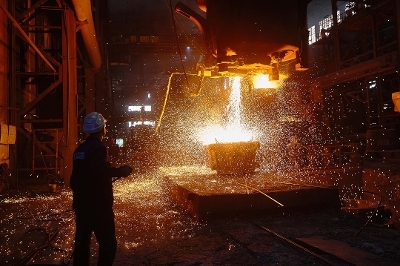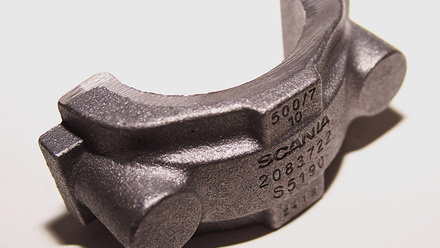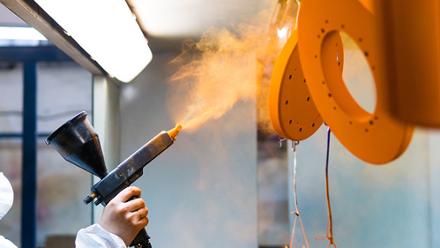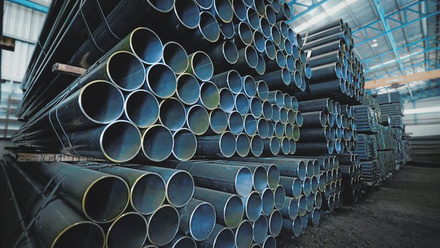Reframing fracture mechanics
John Campbell FIMMM, Emeritus Professor of Casting Technology at the University of Birmingham, UK, suggests the core theory behind fracture mechanics has been overlooked.

When Professor John Knott, Head of the Metallurgy and Materials Department at Birmingham University, spoke of the initiation of a crack he would say, ‘A crack always initiates from a pre-existing crack-like defect.’ And he would always emphasise the word ‘pre-existing’.
This would of course have been approved by Alan Arnold Griffith, who, exactly 100 years previously, proposed that the pre-existence of crack-like defects is necessary to initiate failure by cracking.
What Griffith did not say, but what his proposal implies, is that without a pre-existing crack a metal will not fail by cracking. This is a conclusion of immense significance and seems to be accepted by all working in fracture. Over the years, it seems to have become accepted that none of those atomic fracture mechanisms proposed to explain the initiation of fracture actually work. The once widely accepted dislocation pile-up mechanism has been intensively studied, but the development of a crack from a pile-up has never been observed.
Similarly, the elegant lattice models involving the interaction of dislocations, proposed by Alan Howard Cottrell, have never been verified experimentally and have now fallen into disuse. The absence of any natural lattice or atomic mechanism built into metals to initiate cracks is independently confirmed by the fact that practically all our engineering metals are intrinsically ductile (only very few, including tungsten, chromium and beryllium are intrinsically brittle). We have to conclude that our engineering metals cannot, of themselves, initiate failure by cracking.
Pre-existing defects
The global acceptance of Griffith’s pre-existing crack concept is particularly interesting because it has other implications which, in general, the world appears to have overlooked. The fact that it is possible to start a crack in a metal by an engineer making a hacksaw cut or designing in some other stress raiser at any arbitrary location, means that Griffith defects must be present in huge numbers throughout the metal for one to be always present in precisely the location the engineer happens to choose.
Griffith himself may have realised that his concept of a pre-existing crack implied a dense population of pre-existing cracks because he went on to predict that ‘the effective strength of technical materials might be increased 10 or 20 times at least if the flaws could be eliminated’. In part confirmation of this prediction, it is now clear from much recent theoretical and experimental work, that defect-free metals have huge strengths in the multiples of GPa, deriving directly from the strength of their interatomic bonds.
It is regrettable therefore that the existence of a dense population of crack-like defects in our engineering metals has been consistently overlooked. Only recently have the implications of Griffith’s predictions been demonstrated to be accurate, providing the welcome final piece to the jigsaw that explains much metallurgy for the first time. This has emerged from research over the past few decades at the University of Birmingham but confirmatory results are now appearing from laboratories and foundries worldwide.
Griffith did not speculate about the nature of his pre-existing cracks, how they arose, or how they might be eliminated but the answers to these interesting and important questions are now clear.
The problem with bifilms
The cracks are doubled oxide films whose dry oxide surfaces have impinged face-to-face, experiencing no bonding and therefore acting as a crack, but whose external faces are in perfect atomic contact with the matrix.
Bifilms are the necessary consequence of metals consolidating from particles or fragments into macroscopic engineering forms. A particulate process such as powder metallurgy creates a fine but dense population of bifilms from the trapping of the double layer of oxide between every powder particle. For casting processes, the drops, splashes and folding actions create a wide spectrum of bifilm crack sizes, from submicron to, on occasions, the size of newspapers, explaining the potential for wide scatter of properties in castings.
It seems that the presence of bifilms is fundamental to the mechanism of fracture, and will, with regret, be a shock to many. The image on the previous page represents a cracked carbide inclusion as might commonly be seen under the microscope in a grain boundary of a steel. The crack may or may not extend somewhat into the matrix. The traditional common-sense explanation for this structure is that the inclusion was originally crack-free but because it was weak and brittle the application of stress caused it to crack. Naturally, the crack may now propagate into the matrix. Thus, the sequence of logic proceeds from: (i) inclusion to (ii) stress to (iii) crack. Nearly all cracking of steel appears now to be attributed to the presence of cracked carbides.
Unfortunately, this explanation is not correct. A different, experimentally demonstrated interpretation of the image is now known. Instead of the inclusion being present first, and then suffering stress which finally creates a crack, the logic is reversed. The reality is that the crack existed first and the inclusion forms second. Furthermore, at no stage is stress necessarily involved.
By way of explanation, the crack pre-exists because it was created in the casting process. During the casting of nearly all our metals, particularly special steels as ingots, the immense turbulence encourages dense clouds of bifilm defects to form in our steel and nickel-base ingots. Continuously cast metals and alloys are somewhat better, but still far from satisfactory. During the metal’s subsequent solidification, inclusions nucleate and grow on the wetted outer surfaces of the bifilm. Thus, the inclusion appears to be cracked as a result of containing its originating favoured double-oxide substrate.
Pursuing the logic ruthlessly, we shall conclude that, in general, the inclusion, and sometimes even the stress, can both be redundant to the cracking mechanism. If this is true, how could we have got it so wrong? We have to conclude that our traditional reversed thinking has been not merely unfortunate, but has been a disaster for our understanding of metallurgical failure and for metallurgical understanding in general. It has provided an inverted paradigm to mislead all our thinking, research and teaching for nearly a century.
The proposed reversal of our normal metallurgical thinking is so alarmingly counter-intuitive that a reasoned justification can hardly be achieved in a short account as this. Even so, a cursory overview will be helpful to indicate some of the scope of new possibilities.
Liquid to solid

To achieve a good quality of metal, we need to control our metallurgical practices from the liquid state through to the solid. In particular, the existence of cracks in the liquid state is not an easy concept for those of us who have received merely an education and training in physical metallurgy. Through no fault of our own, but instead that of our current educational system for metallurgists, many of us know little or no process metallurgy. The conditions in the liquid that influence fracture in the solid are essentially simple in nature, are described by good physics, but have yet to be included in the syllabus of our teaching institutions.
The entrainment of the liquid metal surface to create bifilms is disarmingly simple. Any impingement of splashes or droplets, or any folding of the surface, brings together the upper dry surface of the oxide film to meet the face of its impinging identical film, creating a double film with zero bonding between the two dry ceramic faces, represented in the image opposite.
During turbulent transfers, such as pouring the metal during the casting process, there is a maelstrom of bifilm formation. For ingot steels, while uphill poured, the volume mix of air and metal consists of at least 50% air. It is only thanks to the large density difference between liquid steel and its oxides that a large proportion (but not all) of this damage manages to float out in the time available before solidification.
Sufficient bifilms therefore remain to occupy most of the grain boundaries in many metals. They tend to sit at grain boundaries because during recrystallisation or grain growth the boundaries migrate until they meet a bifilm. However, having arrived at the bifilm, they cannot, of course, cross the air gap between the two films. Thus they are pinned at the bifilm. In effect, the bifilm becomes the grain boundary, and appears to have led over the years to the misunderstanding of grain boundaries as being ‘weak’. Molecular dynamic models confirm the immense strength of boundaries.
The bifilms not only act as a population of cracks, But their outer surfaces are in perfect atomic contact with the matrix, having been originally the underside of the surface oxide film which had grown atom by atom from liquid metal. These perfectly wetted interfaces appear to have a key role as favoured substrates for many (if not most) intermetallics and second phases. These include many of the well-known phases in metals - the flake graphite in grey cast iron, carbides (and probably nitrides, sulphides, borides etc.) in steels, tetragonal close-packed (TCP) phases in Ni-superalloys, and metallic silicon and iron-rich phases in Al alloys. The precipitating phase favours formation on a bifilm because much of the transformational strain of its volume and shape change can be easily accommodated by the bifilm’s air gap.
Formation and growth of inclusions and second phases on bifilms prize open the bifilm. There is evidence for this effect in the ‘fish-eye’, the curious and otherwise unexplained feature seen on fracture surfaces, particularly fatigue fracture surfaces.
Re-thinking grain boundaries
Interestingly in most metal microstructures, grain boundaries are seen, some decorate with a precipitate but others remain clear. It seems possible that those displaying precipitates are those that contain a bifilm. In contrast to our traditional thinking, precipitates probably do not form on grain boundaries, but only on bifilms.
A cursory look at invasive corrosion processes such as pitting corrosion or stress corrosion cracking (SCC), shows that opened grain boundary pathways through the metal explain many observed features of this insidious failure mechanism. A penetrating corrodant will be sucked into a narrow crack by capillary forces (assuming a surface tension of 0.1N/m and 2µm gap gives a one atmosphere penetration pressure).
In addition, decoration of the crack with second phases will provide corrosion couples driven by the electrochemical potentials. Applying tensile stress will expand the existing network of cracks, lowering viscous resistance to the penetrating fluid and the internal pressure, enhancing the pressure difference to promote the rate of inward flow, leading to the attack and dissolution of the highly stressed load-supporting regions between bifilms.
Failure mechanisms
Hydrogen embrittlement (HE) is similarly provided with a new and apparently cogent explanation around the formation of blisters, where hydrogen diffuses into pre-existing bifilm cracks lying just under the surface. These blisters are noted with irritation and dismay but not understood in laboratory studies of HE. The bifilms prized open by carbides initially provide hydrogen sinks to buffer any deleterious effects of hydrogen. However, as the hydrogen content of the steel is raised, the internal pressurisation of the bifilms explains the gradual loss of strength and ductility – the internal pressure effectively subtracts from the strength of the steel, culminating in failure.
Fatigue failures can also be explained by bifilm involvement. The standard absence of an initiating period is one simple consequence of a generous population of pre-existing bifilm cracks. More interestingly, the classical step-wise beach marks seen on the fracture surface are usually only seen in some isolated grains, whereas many grains display the curious ‘quasi cleavage’ morphology (‘quasi cleavage’ appears to be so-called because no-one understands what it is). In these regions, the fatigue crack probably proceeds from bifilm to bifilm, from one
pre-existing crack to the next.
Those bifilms flattened during columnar solidification develop to be mainly transgranular, while those from equiaxed freezing become mainly intergranular. Ductile shearing will be expected to facilitate the link between bifilms. Beach marks will denote the slow progress across regions containing no convenient bifilm. The quasi cleavage features are therefore those areas of rapid fracture that traverse bifilms – we are observing opened bifilms, hiding in plain sight!
Creep is another failure mechanism which may owe much to bifilms. For instance, in terms of mechanism, it is only to be expected that grain boundary sliding will occur with greater facility for those boundaries harbouring a bifilm. Also, in terms of the new Willshire two-stage model of creep (rather than the traditional view of creep as occurring in three stages), the second stage, which is the acceleration to fracture, would expect to be eliminated in the absence of bifilms.
So, all the failure mechanisms listed above should be solved at a stroke by removing bifilms. Controlling our casting procedures could therefore not be more important. If bifilms are eliminated, which seems possible, failure by cracking should then become impossible. Even simple overload tensile fracture can be avoided. In the absence of bifilms, metals subjected to tension should fail only above their yield points, by plastic flow or twinning, after necking down to 100% reduction in area.
Casting a wider net
Some of our widely-used current casting processes therefore need to be reassessed. The tragic crashes of a number of helicopters over recent years seems to be associated with fatigue, but this fatigue crack failure appears to have been initiated by a tiny corrosion pit, which is far too small to have caused that damage. The failures have therefore not been understood, particularly given that one of the failures was a drive shaft which had been designed with a massive safety factor of five. There seems little doubt that the initiation of the crack was from a bifilm. The emergence of the bifilm at the machined surface of the component permitted the ingress of corrodants such as rainwater or condensates, and thereby formed a corrosion pit.
The steels used for most critical helicopter parts are prepared by the long and costly vacuum arc remelting (VAR) process. Unfortunately, the presence of bifilm cracks in VAR ingots is both predictable and confirmed by their cracking behaviour during forging. This tendency is addressed by machining approximately 5mm off the surface to remove surface cracks. However, recent evidence suggests that the surface cracks can be up to 50mm-deep, and they cannot be expected to heal with the relatively modest hot work the material subsequently receives. Our current VAR material cannot therefore be recommended for critical applications.
In contrast, the secondary refining process, electroslag remelting (ESR), can produce ingot material that, in principle, can be entirely free from bifilm cracks – the liquid encapsulation of the melting and freezing process fundamentally addresses the bifilm issue. But even this process can suffer large internal defects because of electrode casting techniques that occasionally allow pieces of unmelted electrode to fall into the melt.This problem is easily avoidable by modest and low-cost changes to the electrode casting technique. In principle, at the present time, ESR appears to be our only process with the potential for producing totally reliable metal that is fully resistant to failure by cracking.
A Pandora’s box
Bifilms in metallurgy and engineering seem to be here to stay. The simple concept of the bifilm as a pre-existing crack has opened a new and fertile field. Although some might say it is ‘a Pandora’s box’, these misgivings are not easily understood when viewed against Griffith, who put forward the case of pre-existing cracks and whose views have been accepted for the past 100 years.
For the future, the concepts of entrainment and bifilm provide the roadmap for developing manufacturing processes that control bifilms by controlling entrainment and taking advantage of detrainment. The delivery of metals that do not fail by cracking will then have finally been achieved.







